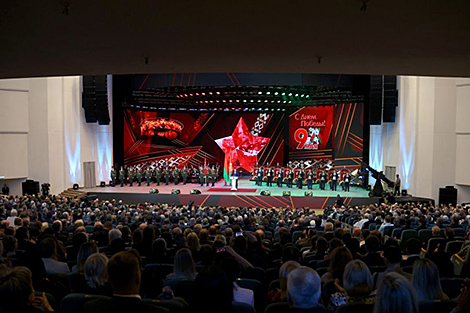Opinions & Interviews
Lukashenko explains details of snap inspection of non-strategic nuclear weapons

MINSK, 7 May (BelTA) – During a solemn meeting held in Minsk on 7 May on the occasion of Victory Day Belarus President Aleksandr Lukashenko revealed details of the ongoing snap inspection of delivery vehicles of non-strategic nuclear weapons, BelTA has learned.
The head of state remarked that in view of the constantly rising military activity in Europe Belarus takes a set of steps to adequately respond to the deteriorating situation. “These efforts to defend our country proceed according to plan and include several stages,” he said.
During the first stage in response to the concentration of military units to the tune of about 90,000 people near Belarus’ northwestern borders the country deployed a reinforced tank battalion and a reinforced mechanized battalion outside Oshmyany and Postavy. The prevention of infiltration of sabotage and reconnaissance forces, illegal armed units into Belarus’ territory was practiced as well as their neutralization and the overall efforts to maintain order near the border.
A snap inspection involving mobilization and full combat readiness of mechanized and air defense brigades was completed against the same background. “A large-scale inspection of air defense forces was the final step,” Aleksandr Lukashenko said.
In his words, these inspections demonstrated the effectiveness of the existing system of combat readiness and mobilization readiness, the ability of brigades to promptly switch to the highest combat readiness status and carry out their missions.
Covering forces are now being rotated in the northwestern direction. Units of a mechanized brigade are moving into new deployment areas. They are being replaced with a reinforced battalion tactical group from another independent mechanized brigade.

“Today we are starting the second stage of practicing the response measures. With this in mind the general staffs of the Armed Forces of Belarus and Russia intend to carry out an inspection of the joint regional military force. There are plans to practice the steps involved in using non-strategic nuclear weapons for the first time as part of this inspection,” the president stated. “In the course of the inspection special munitions will be delivered to missile forces and Air Force units. The munitions will be loaded into launch vehicles and attached to aircraft. Squadrons of Iskander missile systems and Polonez missile systems will clandestinely move to designated positions where they will practice the steps involved in delivering missile strikes to repulse a potential attack against Belarus.”
Meanwhile, Air Force units are preparing frontline attack aircraft Su-25 for carrying out missions involving special munitions in the course of providing support to defending forces and inflicting unacceptable damage to the adversary.
“These actions will proceed against the overall operational and strategic background, which includes the practicing of the use of non-strategic nuclear weapons by Russian troops. Army units of the Moscow military district and the Leningrad military district as well as forces and assets of the Baltic Fleet located in Kaliningrad Oblast will help us obtain operational information,” Aleksandr Lukashenko noted.
The decision on the joint coordination and the deployment of army units for the sake of using the special munitions will be discussed by the leaders of Belarus and Russia at a meeting in Moscow on 8 May. “And we will make the final decision,” the head of state said.
“Direct control of the troops, the authorization of training deployment of the non-strategic nuclear weapons will be done by the general staffs of Belarus and Russia in accordance with the existing interaction plans,” he added.







 print version
print version make home page
make home page add to bookmarks
add to bookmarks

